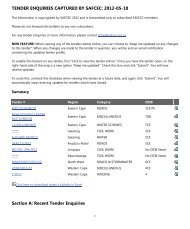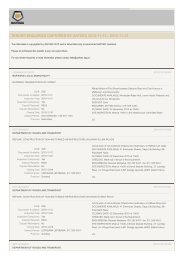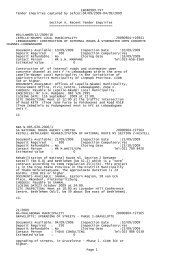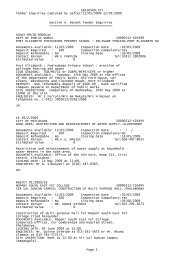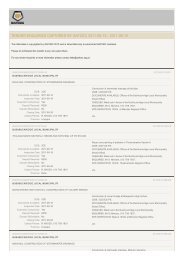DIGEST 2006 - Sabita
DIGEST 2006 - Sabita
DIGEST 2006 - Sabita
You also want an ePaper? Increase the reach of your titles
YUMPU automatically turns print PDFs into web optimized ePapers that Google loves.
elative<br />
fluctuation by<br />
increasing our<br />
proportion of<br />
gravel used,<br />
at a point<br />
where the<br />
supply of<br />
domestic<br />
gravel is<br />
facing new<br />
constraints,<br />
this can only<br />
push up the<br />
expected cost<br />
of gravel.<br />
Secondly –<br />
and much<br />
more<br />
importantly –<br />
basic<br />
materials are far from the largest<br />
cost component of either surfaced<br />
or gravel roads. In the case of<br />
bitumen roads, costs of labour,<br />
plant, investigation, design, road<br />
marking, signage and other inputs<br />
make up a minimum of 75% of<br />
total construction and<br />
maintenance costs.<br />
Labour intensive methods<br />
With the exception of plant these<br />
additional inputs are mainly<br />
domestically produced – and to<br />
the extent that we increase<br />
emphasis on labour-intensive<br />
methods, machinery can be<br />
increasingly domestically sourced<br />
as well. By contrast, the largest<br />
cost component by far in<br />
construction and maintenance of<br />
gravel roads is haulage associated<br />
with the replacement of lost<br />
wearing course gravel. Gravel is<br />
heavy. It is most often carried in<br />
Figure 2 (Source StatsSA)<br />
trucks. Trucks run on petroleum<br />
(diesel) fuel. This expenditure,<br />
unlike increased expenditure on<br />
bitumen, occurs beyond the first<br />
year of a road project. Thus the<br />
proportional impact of rising fuel<br />
prices on road construction costs<br />
goes steadily upward for gravel<br />
relative to bitumen as time<br />
horizons are extended. To the<br />
extent that rising fuel prices are<br />
expected to be a negative external<br />
shock on road budgets, their<br />
proportionate impact is greater<br />
than on surfaced road prices given<br />
the use of the discount rate<br />
employed for most public<br />
investment purposes.<br />
Third, because the proportion of<br />
gravel road cost inflators (diesel<br />
fuel and heavy machinery) that<br />
must be imported are higher than<br />
for surfaced roads, factoring<br />
exchange rate risks into<br />
comparative NPV calculations also<br />
25



